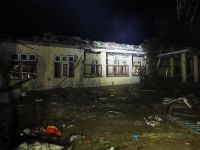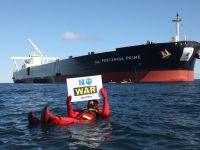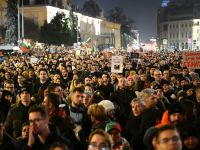Kuwait contains 96.5 billion barrels of proven oil reserves (including its share of the Neutral Zone), or roughly 9 percent of the world's total oil reserves. Along with Saudi Arabia and the United Arab Emirates, Kuwait remains one of the few oil producing countries with significant excess oil production capacity.
Note: Information contained in this report is the best available as of August 2000 and can change.
BACKGROUND
As one of the world's leading oil producing states, Kuwait's economy is heavily dependent on oil revenues. With the steep rise in oil prices in late 1999 and 2000, Kuwait has reaped a revenue windfall. Kuwait's real gross domestic product (GDP) grew by 2.1 percent in 1999, after falling 10.5 percent during the slump in oil prices in 1998. Real GDP growth for 2000 is projected at 5.5 percent.
The period of low oil prices in 1998 and early 1999 spurred the Kuwaiti government to take action to begin reducing government subsidies, which provide many services to Kuwaiti citizens at little or no cost. Even with the recent rise in oil prices, these efforts have continued.
Kuwait has started a program to privatize state-owned businesses (outside the oil sector) as a way of reducing subsidies. As part of this program, the Kuwaiti government has begun privatizing health care, electricity, and telecommunications assets.
Privatization is complicated by the need to protect the jobs of Kuwaiti citizens, who traditionally have been employed mostly (93 percent) by state-owned enterprises and the government. Overall, though, the government is attempting to reduce its involvement in the economy, reducing its budget deficit by cutting subsidies and increasing revenues.
In the oil sector, the Kuwaiti constitution forbids foreign ownership of Kuwait's mineral resources, but the Kuwaiti government is exploring allowing foreign investment in upstream oil development under terms which provide for per-barrel fees to the foreign firms rather than traditional production sharing agreements (PSA's). The idea is highly controversial in Kuwait, and thus far opposition in the Kuwaiti parliament has stalled the initiative.
Kuwait's foreign policy continues to focus on regional security issues. Since Operation Desert Storm in 1991, Kuwait has maintained close military cooperation with Western countries. In October 1994, the United States, the United Kingdom and other countries came to Kuwait's assistance after Iraq moved 70,000 troops and heavy armor close to the Kuwaiti border.
In November 1994, Iraq officially recognized Kuwait's sovereignty, territorial integrity and political independence, as well as its borders as defined by the United Nations. Kuwait welcomed the move but continues to demand the release of all Kuwaiti citizens detained in Iraq and called for international sanctions against Iraq to be maintained until it was in compliance with all pertinent U.N. resolutions.
OIL:
Kuwait contains an estimated 94 billion barrels of proven oil reserves, more than 9 percent of the world total. The Neutral Zone area, which Kuwait shares with Saudi Arabia, holds an additional 5 billion barrels of reserves, half of which belong to Kuwait. Most of Kuwait's oil reserves are located in the 70-billion barrel Greater Burgan area, which comprises the Burgan, Magwa and Ahmadi structures.
Greater Burgan is widely considered the world's second largest oil field, surpassed only by Saudi Arabia's Ghawar field. Kuwait's Raudhatain, Sabriya, and Minagish fields have large proven reserves as well, with 6 billion, 3.8 billion, and 2 billion barrels of oil, respectively. All of these fields have been producing since the 1950s.
They generally contain medium to light crude oil with gravities in the 30o-36o API range. The South Magwa field, discovered in 1984, is estimated to hold at least 25 billion barrels of light crude oil with a 35o-40o API gravity.
Another Kuwaiti field -- Ratqa -- has been the subject of controversy. Once thought to be an independent reservoir, Ratqa is actually a southern extension of Iraq's super-giant Rumaila field. During the weeks preceding Iraq's August 1990 invasion of Kuwait, Iraq had accused Kuwait of stealing billions of dollars worth of Rumaila oil, and had refused to negotiate a sharing or joint development arrangement for Ratqa and southern Rumaila.
After the Gulf War of 1991, a United Nations survey team made a demarcation of the border between Iraq and Kuwait, and this demarcation put all 11 of the existing wells at Ratqa within Kuwaiti territory.Kuwait Petroleum Corporation (KPC) also has been conducting seismic survey work on its largest island, Bubiyan, near Iraq. The initial data is considered promising, and exploratory drilling is planned.
Current Oil Production:
The bulk of Kuwait's oil production occurs at the onshore Greater Burgan field, whose Burgan, Magwa, and Ahmadi structures produce roughly 1.6 million barrels per day (bbl/d) combined. Most of Kuwait's other producing fields are relatively small and include the 250,000-bbl/d Raudhatain, 160,000-bbl/d Sabriya, 60,000-bbl/d Minagish, and 60,000-bbl/d Umm Gudair fields.
Construction of new gathering centers is a major focus of Kuwait's upstream capacity expansion program. Prior to the Iraqi invasion in 1990, Kuwait had 26 gathering centers (GCs), with a total capacity of 4 million bbl/d. All 26 GCs were either damaged or destroyed during the war.
By 1993, operations at 18 GCs had been restored. In January 1996, KPC awarded China Petroleum Engineering Construction Corporation (CPECC) a $390-million contract to build two new GCs, a significant step in Kuwait's efforts to increase its oil production.
CPC is constructing the GCs, designated GC-27 and GC-28, at the Minagish and Umm Gudair fields. The work was to have been completed in 1998, but construction delays have pushed the scheduled completion date back to early 2001.
Kuwait announced in July 2000 that it intended to launch an international tender later in the year for a package of additional infrastructure inprovements which would allow it to increase its export capacity to 3 million bbl/d. Plans include the construction of two additional mooring buoys at Mina al-Ahmadi, additional storage capacity, and additional pumping stations.
Crude Oil Exports:
Kuwait exports the majority of its oil to Asian countries, especially Japan. Other oil exports go to Europe and to the United States, which averaged 223,000 bbl/d of Kuwaiti oil imports during the first quarter of 2000. This compares to the peak of 353,000 bbl/d (4.1 percent of U.S. oil imports) reached in 1993. Kuwait's export blend is 31oAPI (a typical medium Mideast crude), and is considered sour with 2.5 percent or greater sulfur content.
Kuwait has completed major renovations of Mina al-Ahmadi, the country's main port for the export of crude oil. Kuwait also has operational terminals at Mina Abdullah (repairs completed in September 1992), Shuaiba (restored by late 1996) and at Mina Saud.
Production Quotas and Pricing:
In March 2000, OPEC members agreed to reverse the production cuts which had taken effect April 1, 1999. In June 2000, OPEC ministers agreed on another round of production quota increases. Kuwait's quota was set at 2.04 million bbl/d, effective July 1, 2000. As of June 2000, Kuwait was producing 2.1 million bbl/d.
Plans to Expand Oil Production:
Although it has undertaken production cutbacks this year in response to the period of low oil prices in 1998 and early 1999, Kuwait still aspires to increase its production capacity from the current 2.4 million bbl/d to 3.5 million bbl/d by 2005. To facilitate the increase in capacity, Kuwait is considering permitting foreign oil companies to invest in upstream production, which would reverse more than two decades of Kuwaiti policy.
The current policy, in place since 1975, limits the participation of foreign oil companies to providing technical assistance and construction and maintenance services under contracts, which pay them fixed prices for specific activities. In fact, Kuwait's constitution forbids the award of concessions which give an ownership interest in Kuwait's natural resources to foreign entities.
Nevertheless, the government has repeatedly hinted at a desire to find a way to involve foreign oil companies in increasing production without violating the constitution. The Supreme Petroleum Council (SPC) in 1997 approved foreign cooperation in principle, but opening upstream activities to deeper involvement by foreign oil companies is highly controversial with opposition members of the Kuwaiti parliament.
The structure of the agreements the government is considering, called "Operating Service Agreements," unlike PSA's, allows the Kuwaiti government to retain full ownership of the oil reserves. The foreign firms, however, would be paid a "per barrel" fee, along with allowances for capital recovery and incentive fees for increasing reserves.
The fields which the Kuwaiti government intends to open to foreign investment are all currently operating fields in northern or western Kuwait, including Rawdaitain, Sabriyah, Ratqa, Bahra, Minagish, and Umm Gudair. Kuwait's largest field, Burgan, is to remain off-limits to foreign investment under the new plan.
Kuwait held a formal conference in November 1999 to discuss the upstream opening, but the initiative has been stalled by strong political opposition. In February 2000, the Kuwaiti parliament passed a resolution calling on the government not to proceed with the program until legal issues involving foreign interests in the Kuwaiti oil sector were resolved. New legislation dealing with the foreign investment program is currently under consideration in the Kuwaiti parliament.
Neutral Zone:
The Neutral Zone encompasses a 6,200 square-mile area partitioned equally between Kuwait and Saudi Arabia under a 1992 agreement. The Neutral Zone contains an estimated 5 billion barrels of oil and 1 trillion cubic feet (Tcf) of natural gas. Oil production in the Neutral Zone, which is over 500,000 bbl/d, is exported from area terminals. Two joint ventures control oil production in the area.
Onshore, U.S.-based Texaco and KPC produce from the Wafra, South Fawaris, and South Umm Gudair fields. Offshore, the Arabian Oil Company (AOC) of Japan operates the Khafji and Hout fields, both of which are connected to Saudi Arabia's Safaniyah, the world's largest offshore oilfield.
AOC has a 40 percent stake in the Kuwaiti portion, with the remaining 60 percent held by KPC. AOC lost its concession in the Saudi sector when it expired in February 2000. Kuwait's intentions on the issue of renewal are unclear.
Foreign Upstream Operations
Even though Kuwait's overall overseas investments are considerably smaller than before the 1990 invasion by Iraq, Kuwait holds equity interests in oil production in several countries through the Kuwait Foreign Petroleum Exploration Company (KUFPEC).
KUFPEC is active in Algeria, Australia, China, Congo, Egypt, Indonesia, Pakistan, Thailand, Tunisia, and Yemen. Most of the interests are either small fields or minority stakes, though, and KUFPEC's revenues have been under $200 million in recent years, making it a relatively minor part of Kuwait's state oil establishment.
SOURCE: UNITED STATES ENERGY INFORMATION ADMINISTRATION
© 2000 Mena Report (www.menareport.com)







